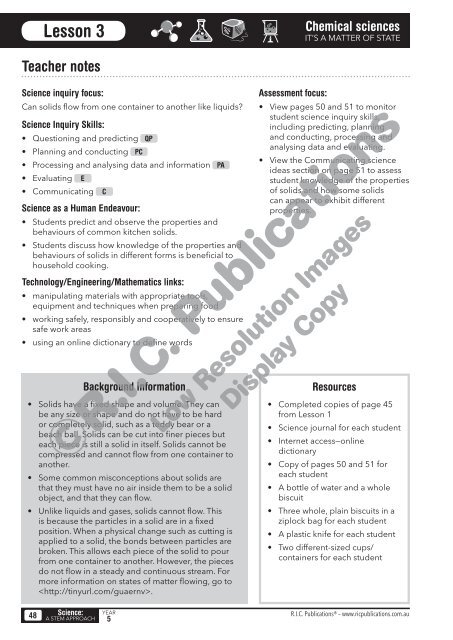20389_Science_with_STEM_Year_5_Chemical_Sciences_Its_a_matter_of_state
Create successful ePaper yourself
Turn your PDF publications into a flip-book with our unique Google optimized e-Paper software.
Lesson 3<br />
<strong>Chemical</strong> sciences<br />
IT’S A MATTER OF STATE<br />
Teacher notes<br />
<strong>Science</strong> inquiry focus:<br />
Can solids flow from one container to another like liquids?<br />
<strong>Science</strong> Inquiry Skills:<br />
• Questioning and predicting QP<br />
• Planning and conducting PC<br />
• Processing and analysing data and information PA<br />
• Evaluating E<br />
• Communicating C<br />
<strong>Science</strong> as a Human Endeavour:<br />
• Students predict and observe the properties and<br />
behaviours <strong>of</strong> common kitchen solids.<br />
• Students discuss how knowledge <strong>of</strong> the properties and<br />
behaviours <strong>of</strong> solids in different forms is beneficial to<br />
household cooking.<br />
Technology/Engineering/Mathematics links:<br />
• manipulating materials <strong>with</strong> appropriate tools,<br />
equipment and techniques when preparing food<br />
• working safely, responsibly and cooperatively to ensure<br />
safe work areas<br />
• using an online dictionary to define words<br />
Background information<br />
• Solids have a fixed shape and volume. They can<br />
be any size or shape and do not have to be hard<br />
or completely solid, such as a teddy bear or a<br />
beach ball. Solids can be cut into finer pieces but<br />
each piece is still a solid in itself. Solids cannot be<br />
compressed and cannot flow from one container to<br />
another.<br />
• Some common misconceptions about solids are<br />
that they must have no air inside them to be a solid<br />
object, and that they can flow.<br />
• Unlike liquids and gases, solids cannot flow. This<br />
is because the particles in a solid are in a fixed<br />
position. When a physical change such as cutting is<br />
applied to a solid, the bonds between particles are<br />
broken. This allows each piece <strong>of</strong> the solid to pour<br />
from one container to another. However, the pieces<br />
do not flow in a steady and continuous stream. For<br />
more information on <strong>state</strong>s <strong>of</strong> <strong>matter</strong> flowing, go to<br />
.<br />
Assessment focus:<br />
• View pages 50 and 51 to monitor<br />
student science inquiry skills,<br />
including predicting, planning<br />
and conducting, processing and<br />
analysing data and evaluating.<br />
• View the Communicating science<br />
ideas section on page 51 to assess<br />
student knowledge <strong>of</strong> the properties<br />
<strong>of</strong> solids and how some solids<br />
can appear to exhibit different<br />
properties.<br />
Resources<br />
• Completed copies <strong>of</strong> page 45<br />
from Lesson 1<br />
• <strong>Science</strong> journal for each student<br />
• Internet access—online<br />
dictionary<br />
• Copy <strong>of</strong> pages 50 and 51 for<br />
each student<br />
• A bottle <strong>of</strong> water and a whole<br />
biscuit<br />
• Three whole, plain biscuits in a<br />
ziplock bag for each student<br />
• A plastic knife for each student<br />
• Two different-sized cups/<br />
containers for each student<br />
©R.I.C. Publications<br />
Low Resolution Images<br />
Display Copy<br />
48 <strong>Science</strong>:<br />
A <strong>STEM</strong> APPROACH<br />
YEAR<br />
5<br />
R.I.C. Publications® – www.ricpublications.com.au


















